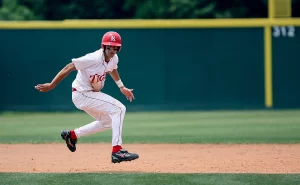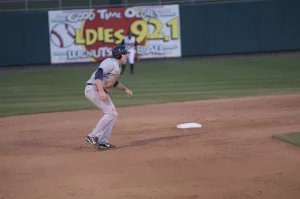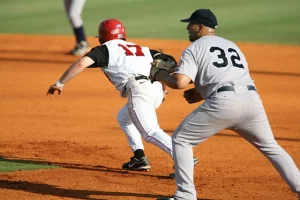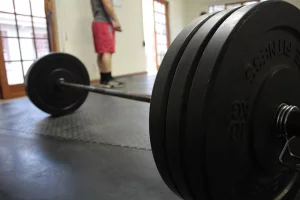Improve your baserunning to help your team win games
When training for baseball, it’s likely you put a great amount of time into becoming a better hitter. It also makes sense that you’re giving a lot of effort to your defensive skills or pitching. When we are talking about baseball training, hitting and defense are a no brainer. It’s a given that you will be trying to be the best you can be in the batter’s box or on the field. But, there’s another skill in baseball that is often overlooked in training. Baserunning.
You can’t win ball games if your team isn’t scoring runs.
At the end of the game, having a bigger number on the scoreboard than your opponent is the only stat that matters. Baseball is a team game. Everything we do should be geared towards scoring runs when our team is at bat and stopping them when we have the ball.
The way you run the bases can make a big difference. Doing what you can to gain extra bases for your team will go a long way toward your team’s success. Likewise, not running into outs increases your chances to score. You are putting your energy into being a slugger at the plate and a baller on defense. To be an even better all around player, though, you should be training to improve your baserunning abilities with the same intensity.
Common baserunning mistakes

You hit a ball that you think is out and start jogging. Or you hit a high fly ball and put your head down as you slowly make your way to first. Suddenly, the ball hits the ground, and instead of being on second base, you’re only halfway to first. One of the most embarrassing things in baseball is the 300+ foot single. You can try to justify your lack of effort in that situation, but it won’t fly. Anyone watching in the stands, on the field or in the dugout knows you blew it. Good teammates don’t stop hustling until the play is over.
Other baserunning mistakes you might be making:
- You’re on base, casually leading off, and before you know it you’re picked off and walking back to the dugout.
- You aren’t ready when the ball is hit. Now you are an easy out force out. Or you only get one base on a hit to the outfield instead of two.
- You get the steal sign from the coach. But you haven’t been studying the pitcher’s delivery and you get a bad jump. Now you’re gunned down by the catcher.
- Were you paying attention to the way the outfielders are fielding the ball? How about their arm strength? No? You just cost you’re team a run.
- What’s the situation? You didn’t tag up when necessary or didn’t start running with 2 outs.
- You didn’t pay attention to your base coach before rounding second.
- Did you fail to advance on a passed ball or error?
- You think that baserunning doesn’t matter.
Mistakes can happen. But they are inexcusable when you refuse to address them.
Baserunning errors cost runs
All of these mistakes affect the game. When you commit these mental errors, the team you’re facing is calling you their MVP. You just handed them an easy out or kept a run off the board. One thing I see all too often in baseball games, especially at the youth and adult level, is players running into outs or not running with intent. These are mistakes that can easily be fixed with a change in mentality and training.
“Running the bases is as much a part of baseball as batting, throwing and catching”
You wouldn’t just go up to bat and flail at the ball. And you’d be benched quickly if you just lobbed the ball from the mound. When you are on the field, it’s expected for you to give your best effort to help your team. Off the field, you train to be an asset for your club. Running the bases is as much a part of baseball as batting, throwing and catching. So, practice and prepare that skill as much as you do the others.
Learn to own the base paths
Just like with other skills you work to improve, you should be learning to master baserunning. Some things you can do to get better are simple and can make a difference right away. Others will take time to develop, but can certainly be built if you make it a priority in training.
If you practice baserunning with the same intensity and concentration, you’ll be adding an important weapon as a baseball player. Pitching can neutralize hitting. But it’s difficult for defenders to combat an opponent’s speed and base awareness. A good running game is an asset to every player. Below are attributes every player should be implementing into their baserunning.
Win the mental
hustle
This is the number one rule. If you don’t do anything else as a runner, hustle.

You should already be doing this, both on offense and defense. Speed isn’t even a factor when it comes to hustling. Whether you are fast, slow or in between, you should be moving with maximum intent.
On the basepaths, this starts from the moment you put the ball in play to the time you cross home plate. Getting down the line as fast as possible should be a no brainer. Unfortunately, all too often players aren’t running at full speed when the ball is live. They may think there’s no point because it’s going to be an easy out, only possible to get one base, or maybe, that the ball is going over the fence. These excuses are unacceptable and often come back to hurt the team. There is never a reason not to run it out. Always go hard until the play is over.
“Every base matters in baseball.”
Running with maximum effort can make things happen for you. It often will make defenders rush to field or throw a ball. While you may still get out, the chance of a ball getting booted or a throw sailing away goes up when you make the fielders rush. If you are jogging to the base, you are just giving them plenty of time to make a play. Hustling can force errors that can help your team.
We’ve all seen it in a game. The bang-bang play at the base, where it seems the ball and runner arrive at the same time. Hustling can get more of those plays to go your way. Every base matters in baseball. Do everything possible to get as many as you can safely.
awareness
As soon as the ball is hit, you should be running at full speed to the next base. I often hear the phase, ” put your head down and run”. This saying, while well intentioned, is misleading. You should be running, yes, and starting low out of the gate. But you should also have your eyes up in order to pick up keys to what is going on with the ball. You probably already have an idea of where the ball went when it was hit. But a glance out the side of your eye, a read of the defender or picking up the directions of your base coach will have you prepared.

Awareness has many aspects. It starts with knowing the game situation. The inning, how many outs, runners on base, defensive positioning and the score are all factors that you should know before the play begins. They are important to know for better decision making once the ball is live. You may need to be a bit more aggressive or subdued with your decisions depending on the point in the game and needs of your team.
When the ball is in play, its important to know where it is, where the likely play will be, and if possible, the skill level of the defenders. Knowing the capabilities of the fielder on a single to left field goes into your decision to try to score from 2B or not. You’re base coach should be giving you guidance, but being able to anticipate the play gives you an advantage when running.
Being aware on the diamond helps you to stay ready for any situation that may come. It prevents outs that hurt your team and puts you in a great position to gain extra bases.
focus
When you are on base, you have a job to do. Get to the next base. That’s not going to happen if you aren’t ready when the pitch is thrown, or worse, you get picked off base. As a baserunner, you need to stay focused on the ball and be ready to react.
Know where the ball is at all times!
Pay attention to the pitcher. What’s their delivery? What’s their pick off move? How hard and accurate do they throw? Don’t even step off the base until you can give the pitcher your total focus.
Pay attention to the defense. Are they holding you on base? Are they creeping? Is their positioning going to allow you to take an extra base on a hit?
Make sure you are checking with the coach before you step off. They may be giving you the steal sign or calling for a hit and run. It’s your job to be ready to go.
Additionally, if a batted ball hits you, you are out. Don’t ever let that happen. Ever. Focus.

win the physical
running
This is simple. Run everywhere and run hard.
When you are running to first base and there’s going to be a play there, run through the bag. On the way, don’t waste steps by studder stepping or short stepping. Get up to speed as quickly as possible and gain ground fast.
When rounding a base, hit the inside of the base. Start curving your path before the base and fire off straight to the next one. Use the base itself to give extra push off.
Push your self when running. Injuries are often more likely to happen when you try to slow down than when you are running full speed.
lead offs
Leadoffs are an essential part of baserunning. Getting a good lead can be the difference between beating a force out at a base, getting a stolen base or scoring on a hit or pass ball.
At the same time, a bad lead can get you picked off before you even have a chance to advance.

The ideal lead off is one where you are as far away from the base as possible while still being able to get back safely against the pitcher’s best pick off move. Obviously, it is very important that you be focused and aware when taking your lead off.
Step off facing the pitcher. Stay on the balls of your feet and be ready to get back to the base at any moment. Don’t cross your feet as you step since that puts you in a bad position to get back to base. If you cross your feet, a good pitcher will notice and time their move to get you out.
When going back to the base, if diving, go to the back of the bag grabbing for the back (outfield side) corner of the base. If standing, go into the back half of the base, preferably with your right foot and your body turned away from the pitcher. You go in facing away for three reasons.
1. It’s the fastest way in.
2. If the ball is off line and hits you, it’s not hitting your face or groin.
3. If you are facing away you can see where a bad throw goes and quicky decide whether to advance.
When you are good at getting aggressive leads, you can take the pitcher’s attention away from the hitter and get them anxious. That can help your teammate at the plate and force bad pitches.
secondary leads
Once the pitcher delivers to the plate, it’s time for your secondary lead. Don’t start the secondary until the pitcher is committed to going to plate or you may be gifting them an out.
There are three main forms of a secondary lead. The most basic is the creeping lead. This is similar to your primary lead, where you are moving horizontally with your shoulders squared to the catcher. The advantage to this lead is that you are equally prepared to move either back to the previous base or forward to the next.
The next secondary lead is the walking lead. You start walking (in an athletic manner) to gain ground to the next base. This puts you in position to advance, but not with so much momentum that you can’t return to base if the ball goes unhit or is a line drive to an infielder.
The third secondary lead is the most aggressive. It has the highest risk but also has the highest potential pay off. You start running to the next base on delivery. This gives you a great jump for a ball in play, which can give you an extra base on a hit or a pass ball. But you need to be very focused. You are in a more dangerous position to get back picked by the catcher or be too far off the base to get back on a line drive. This lead should only be used by those that are comfortable on the basepaths.
stealing bases
Stealing bases isn’t for every one, but all ball players should be ready to swipe a base if they are called upon.

You are stealing off the pitcher. That’s not to say the catcher’s arm isn’t an huge factor in the decision to go. What it means, is that you are taking your cue to go from the pitcher. You need to pay attention to their delivery to time your jump. A lot of pitcher’s have different moves to the plate when runners are on, such as a slide step or leg kick. Studying the pitcher from the dugout and on deck circle can help prepare you.
“Don’t get caught leaning.”
Stealing a base relies on a good read of a pitcher, but as important is a good jump. This takes good reaction time. This can be trained and should be. It’s also aided by good anticipation. Being ready to go is essential. Don’t get caught leaning though. The pitcher will be waiting for that.
If you get the steal sign, get a good jump, run at top speed and plan on sliding to the outer part of the base.
delayed steal
The delayed steal, requires you to be skilled at reading the pitcher, catcher and infield. It’s a strategic move usually called for when you can catch the catcher sleeping or the infielders are too far off the next base. It can be high risk because you will be in no man’s land, but it can be very successful when pulled off right.
As you already should be, pay close attention to the pitcher and catcher. Is the catcher prepared to throw after receiving the pitch. Does the pitcher turn away from you after getting the ball back? Are the infielders paying attention? A good delayed steal usually happens when the catcher isn’t paying attention to your secondary lead and isn’t throwing the ball back to the pitcher with authority. After they do this a couple of times, a good baserunner will time this and steal once the catcher starts to throw back to the pitcher.
This can be highly effective and has the added benefit of getting into the opponent’s head. The delayed steal can help to change momentum when your team needs it. Just use it carefully.
sliding
There are many ways to slide. Usually it will come down to a baserunners preference. The slide you choose will usually be tied to your running style. An upright runner is more likely to slide feet first. A runner that stays low and over their front side might slide head first most of the time. Still there will be times when one type of slide might be better than another.
sliding types
There are two main types of slides, but also variations on each. The common slides are feet first and head first.

- A feet first slide has the runner going into the bag with one foot extended and the other bent at the knee. The runner slides along their bottom to reach the front of the base, coming in low.
- The hook slide is a variation of this slide. With this slide, the nonextended leg is bent outward and the runner tries to touch the base with the foot on that leg
- A by-pass slide is a foot first slide where the runner slides passed the side of the base and tags the base with their hand.
- Both variations are typically used to put more distance between the runner and the defender on a tag play. Beware, though, as purposely sliding passed the side of the base to make contact with the defender is now illegal in almost every level of play and can result in an out or outs depending on the intended play.
- A head first slide is when a runner goes into a base head first, with the arms extended to touch the base. This slide is common with runners that run low, or those that want to use their arms to maneuver around a tag. The swim move is a variation of this slide where the runner will reach to the side of the bag while swimming their other arm over or around a tag attempt.
Be aware that many leagues now require you to slide on a potential force or tag play at a base. Be ready to get down when the play calls for it.
Train with intensity
You train for strength, endurance and explosiveness to hit and throw better. You should be doing the same to be a better baserunner. The more strength you have, the better capacity you have for speed and quickness. Getting your body into better shape for running has the bonus effect of preventing injuries too. To get the most out of your time in training, it’s best to have a focus to your drills and work outs.
When it comes to baserunner training your focus should be on overall speed, quickness and explosiveness. While having good overall health and athleticism should be a goal of every player, tailoring your training to you goals is important. Depending on your current physical condition, you may need to work your way up to high intensity training. It’s never a bad idea to check in with a medical pro if you aren’t sure. An added benefit is training for better conditioning helps prevent injuries.
Train as hard as you play!
While speed, quickness and explosiveness are related, they are different skills. Speed is a description of how fast you can move at full speed. Quickness is a measure of how fast you can begin moving (ability to physically react when you tell your body to) and explosiveness is how fast you can go from stopped to top speed. Some drills and workouts will train all of these together while others focus more on one than the others. Working all of these attributes will have you moving better around the bases.
Speed training
The best way to get faster at running is to…run. Doing some mid distance running has a lot of benefit for leg health. While, baseball is more about sprinting, starting with mid distance running will help condition your legs and lungs for more intense speed training. It’s a good place to start.

But because baserunning relies on speed, your running will need to include sprint training. Sprinting uses a different muscle fiber than long distance running does. If you want to run fast you need to build up the capacity and output of those fibers. The best way to do that is with drills geared toward sprints and high intensity weight lifting.
drills
Sprints–Do sprints using different distances. Do them from 30 feet, 90 feet and 180 feet. Work on running with good form. Your arms, legs and feet should be going forward, not side to side. Push off each step from the balls of your feet. Work on getting to maximum speed as quickly as possible and maintaining it through the whole sprint. Make sure you have a good stride and your steps aren’t choppy. Speed is about gaining ground in as short a time as possible. Rest between each sprint to allow your muscles to recover as sprinting is an anaerobic exercise.
Intervals–Run longer distances, keeping at a good pace that you can maintain. Every two minutes, start running full speed for 10-20 seconds, then slow back down to the original pace. Interval sprinting helps you to recruit Type 1 muscle fibers (endurance) to help aid Type 2 muscle fibers (power, speed) when the muscle is already fatigued.
Skipping–Skipping as a drill works the same muscles that you use when pushing off in a sprint. As with running, concentrate on gaining ground on each skip. The goal is to gain as much ground as possible while engaging the ground for as short a time as possible. This will help with both stride and push off.
strength workouts
Strength training–There is a common rumor that building muscle will slow you down. In most cases, this is false. Just look at an Olympic sprinter’s legs or an NFL running back. Where it can slow you down is if you are not training with intensity or a focus on explosive strength. When lifting for speed, you want to lift heavy with low reps (3-5) as that recruits the maximum amount of type 2 fibers. Lifts that are especially good for building your legs for speed include squats, deadlifts, power cleans, and lunges. Make sure you are going through the full range of motion and lifting with intent.
Weighted sled–This work out helps to build up your type 2 leg muscles while also increasing your ability to create force from the ground. There are two types of sleds. You will want to use the pull type. This will have a harness. Put the weight on the sled, strap on the harness, then run. Obviously you will not be going very fast, but you are using the same muscles as sprinting at a higher intensity. The concept of the sled is the same as using a heavy bat to build bat speed.
quickness and explosiveness training
While quickness and explosiveness are different attributes, in most cases the two are paired together.
Quickness is your ability to react mentally and your ability to turn it into physical action. For example, it’s a measure of the time from you seeing the ball leave the pitchers hand, processing that, telling your body to react and it actually reacting. You can see this in a sprinter reacting to the starting gun or a defensive lineman reacting to the ball being snapped.
Explosiveness is your ability to go from a static position to top speed quickly. Great runners are often up to their top speed within a couple steps, whereas, an average runner may not reach their top speed until they are halfway to the base.
Often, training for explosiveness will increase your quickness as well. You are training your muscles to fire at high intensity in a short amount of time. This not only trains the muscle fibers ability to perform, but also the nervous system connection they have with your mind. Working on your explosiveness will make you quicker.
drills
Sprint starts–One of the best ways to learn to start quickly and explosively is to practice it. With this drill, you start from an athletic position, ready to run. Then burst off the line, trying to gain speed as quickly as possible. You don’t need to do a full sprint distance, 10-15 feet is enough. Rest between each rep.
- A good variation of this is to start in the lead off position, horizontal to the line you’ll run. This is what you’ll be doing in games so it’s good to practice it. Make sure your first step is with the back leg, driving the knee toward the target line. Don’t waste a step by turn-stepping the front foot first. Be sure to do this drill to both sides. You want to be explosive back to a base too.
- It is also great to do this with an “external” start. Have a timer alarm or a person tell you when to start. This will help train your reaction time as well as explosive ability.

Workouts
Olympic Lifts–While Olympic lifts are a full body movement, the majority of the work being done is in the lower half of body. Olympic lifters don’t only train for strength. They also need the explosive force to get the bar up over their head. The two main lifts are the snatch and the clean and jerk. They are great for training your ability to derive force from the ground up.
- These lifts are very effective for explosive power, but can be dangerous. I recommend before trying them, you make sure you understand the form needed to perform them properly.
- Make sure there is plenty of room around for you to abandon the lift if necessary.
Plyometrics–Plyometrics are body weight or lightly weighted exercises that areexplosive in movement. They are a great addition to a workout.
- Box jumps involve…you guessed it, jumping onto a box. There are two ways to do this. With a shorter box, you work on jumping on and off the box as quickly as you can for a set amount of reps. The more common box jump is with a taller box, jumping explosively to the top, then slow and controlled coming down. With this box jump the goal is to keep increasing the height of the box to require more force to scale it.
- Skaters are a form of jump running where you are jumping side to side; it looks a bit like ice skating. You push off and land on the other foot then spring back the other way while gaining ground. These are great for building leg responsiveness and lateral movement.
Strong legs are important for hitting, fielding and pitching, in addition to baserunning. These drills and workouts will help your game all around.
Win games with your baserunning
When you treat baserunning as an equally important part of your game, you are on your way to being a complete baseball player. Learn to own the basepaths and run your team to more victories. Develop a competitive running game.
Any day on the ball field is a good day.
What do you do to be a better baserunner?
Let us know in the comments.
